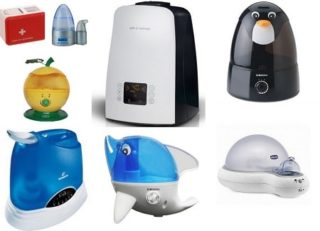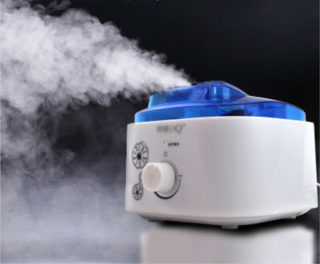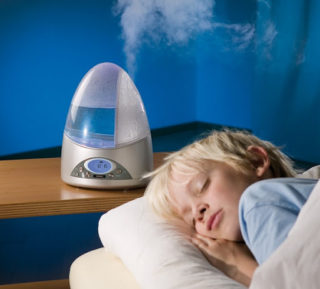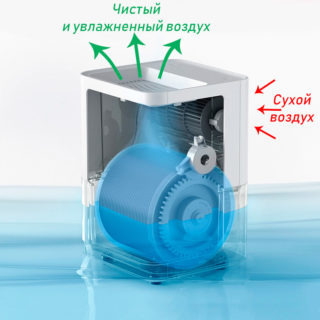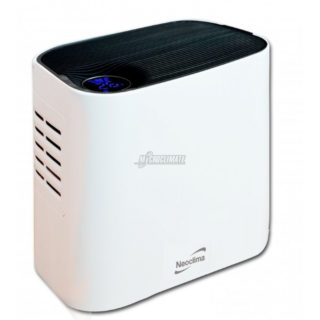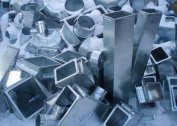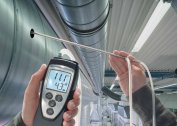To maintain the optimum level of humidity in the room, special devices were invented: cleaners and humidifiers. They are able to remove impurities, ionize air masses, and neutralize unpleasant odors. These devices differ in principle of operation and result. To understand which one is better - air washing or a humidifier after all - it is necessary to study their characteristics.
Varieties and features of humidifiers
Humidifiers are classified according to the principle of operation. Classic models are equipped with filters through which the air flow drawn in by the fan is driven. Contacting with water, the air is humidified. Traditional appliances are characterized by low productivity and can be used in rooms up to 45 m2. The devices do not emit visible vapor, so they can be used in rooms where there are children. They are completely safe. Users are attracted to the fact that in traditional humidifiers you can pour water from the tap. Of the shortcomings, increased noise is noted.
Steam devices are more efficient. Air is humidified faster by heating water. They should not be placed in the nursery, because there is a risk of burns. Hot steam can damage things in the vicinity of the device. Due to the constant boiling of water, scale forms on the heating element. Steam is released intensively, so a lot of electricity and liquid is consumed. It is advisable to use aromatic substances. Some devices are equipped with a hygrometer, as well as protection sensors against use without water and when overheating.
Ultrasonic humidifiers are both more advanced and productive. A piezoelectric element is provided in their design. Under the action of ultrasound, the membrane turns water into cold vapor, which is safe for children. Advantages of equipment:
- silent operation;
- low power consumption;
- high efficiency.
An ultrasonic humidifier is demanding on fluid quality. It is recommended that only distilled water be added.
Advanced devices have additional options: the ability to select the operating mode, numerous settings, determine the level of humidity.
Normal moisture levels range from 40 to 75%. To achieve optimal performance allows any type of humidifier.
The principle of operation of humidifiers
The principle of operation of the humidifier is the forced pumping of air masses by the fan through the water filter and the evaporation of water. In traditional devices, the liquid evaporates naturally, in ultrasonic water fog produced by the action of ultrasound is formed, in steam devices - hot steam.
Depending on the model, the following functions are available:
- 360 degree spraying thanks to a rotating stand;
- light warning about the minimum liquid level;
- shutdown in the absence of water;
- night mode of operation;
- aromatization;
- backlight;
- blocking if the device is not assembled correctly;
- indication when filters are dirty.
Some humidifiers have a cleaning unit, in some models an ionizer. Due to these elements dust, unpleasant odors, and other contaminants are removed.
Advantages and disadvantages of humidifiers
Before you give preference to a particular device, you should find out their advantages and disadvantages. Benefits:
- Environmental friendliness. Steam humidifiers and those models that have an ionization function are distinguished by this quality. They purify the air of viruses and microorganisms.
- Humidifiers, in addition to ultrasonic devices, do not leave a white coating around them.
- Moisturize quickly.
- Classical and ultrasonic devices are absolutely safe.
- UV models work quietly, and steam emits a quiet gurgle.
- Compactness and mobility.
- Reasonable cost.
- Classic and UV devices consume a small amount of electricity.
Of the minuses distinguish:
- risk of waterlogging, especially when using steam devices;
- small radius of action;
- the need to move the device for uniform moisture;
- replacement of pre-filters.
Water from the tap can be filled, but with the constant use of untreated liquid, the life of the device is reduced.
Advantages and functional features of an air wash
Sinks moisturize the air masses in a natural way and clean them. They act on the air like rain, neutralizing dust particles due to water. Sinks are classified into two types: with the effect of a water bath and a hydraulic filter. In the first, water covers the rotating discs with a film and air passes through them, saturated with moisture. Secondly, air masses are passed through a water curtain formed by rotation of the central rod in the tank. The latter kind of devices is less noisy.
As a result of passing through the sink, the air is cleaned and moistened. There is a circulation of air masses. With a fan, the flow spreads throughout the room, and exactly as much liquid as necessary enters the atmosphere. There is no risk of waterlogging, damage to the surrounding furniture, upholstery, wall decoration, since the humidification mechanism corresponds to the natural one.
Sinks clean the home atmosphere of wool, dust, tobacco smoke. Dust and wool remove any model due to exposure to water, unpleasant odors, allergens and bacteria are eliminated with the ionization function.
When choosing an air sink, it is necessary to take into account the features of a particular device.
- There are three control methods: mechanical, touch and electronic. The mechanical one is the most reliable, but the least informative, the touch is impractical and often fails, the electronic version is the most functional, easy to repair and gives comprehensive information thanks to the presence of a screen.
- The model of air washing should be selected taking into account the area of the room. Moreover, the performance of the device should be slightly larger than the calculated values.
- The appliance reservoir must meet two requirements: optimal dimensions and sufficient operating time without adding water. It is believed that a device with a capacity of 7 liters is preferable. Spending 300 ml / h, they work without refueling during the day.
- It is desirable to have “eco” and “night” modes. In night mode, the noise level is reduced, and in economy mode, water and electricity consumption are reduced.
- Some models have a separate compartment for adding aromatic products.
In intensive operation, the sink can consume up to 20 liters of water per daylight hours.
Advantages:
- Effectively clean the air of dirt, pollen and dust.
- Models without additional filters do not filter out microparticles and bacteria.
- They work on the principle of natural circulation, therefore waterlogging is excluded.
- The noise during operation does not depend on the power of the device.
- Ultrasound and heating are not used.
- A large area is being processed.
- White plaque does not form on surfaces.
Disadvantages:
- difficult care;
- high price;
- noisiness
- high water consumption;
- significant dimensions and weight;
- rapid decrease in humidity when the device is turned off;
- the presence of fine filters leads to the need to replace them, which increases maintenance costs.
Due to the wide range, it is not difficult to choose a model for your own requirements: with certain functions, dimensions.
The choice between air wash and humidifier
When choosing between a sink and a humidifier, you need to understand that not a single device, even the most powerful, is designed to humidify air in several rooms. The device can be rearranged from one room to another, but the balance will be disturbed, because in one room the air will be too saturated with moisture, and in the other it will remain insufficiently humidified. You can partially find the way out by installing the device in the hallway or hallway. Then the humidity will spread to adjacent rooms. An important difference between air washing and the humidifier is that in most humidifying devices there is an ionization function, and in sinks this option is rarely found.
In the humidifier and in the sink, you will need to control the water level, and in the humidifier also monitor the readings of the sensors and temperature. Washing is preferable to a humidifier, because it saturates the air with moisture to optimal values, there is no hot steam and air exchange is carried out, which best affects the air balance. But the main difference between a sink and a humidifier is that the sink purifies the air, and the humidifier, first of all, saturates it with moisture.
When leaning in favor of an air purifier or humidifier, several features are considered:
- A sink is an order of magnitude more expensive.
- For a small room, an ultrasonic model is suitable. For a large open area, it is better to purchase a sink, as it is able to efficiently humidify air over an area of up to 100 m2.
- Sinks are recommended for apartments where allergy sufferers, asthmatics and children live.
- Sinks perfectly remove wool, dust and pollen. And if they have the option of ionization, they attract the smallest particles due to static electricity.
- Classic type humidifiers will make noise, but thanks to the natural principle of hydration, they do not emit excess moisture.
- Classic moisturizers do not remove allergens and viruses.
- The humidifier from the air purifier will vary in weight. The first ones are lighter and more mobile, and for washing you need to allocate space on the floor.
Models are better to choose with the ionization function, as they allow you to fight viruses and bacteria. In any case, it is necessary to select the device for performance and the presence of additional functions. The humidifier is recommended as a compact lightweight device for intermittent use. The sink qualitatively moisturizes the air in the house, maintains normal humidity, and is undemanding to water quality.
